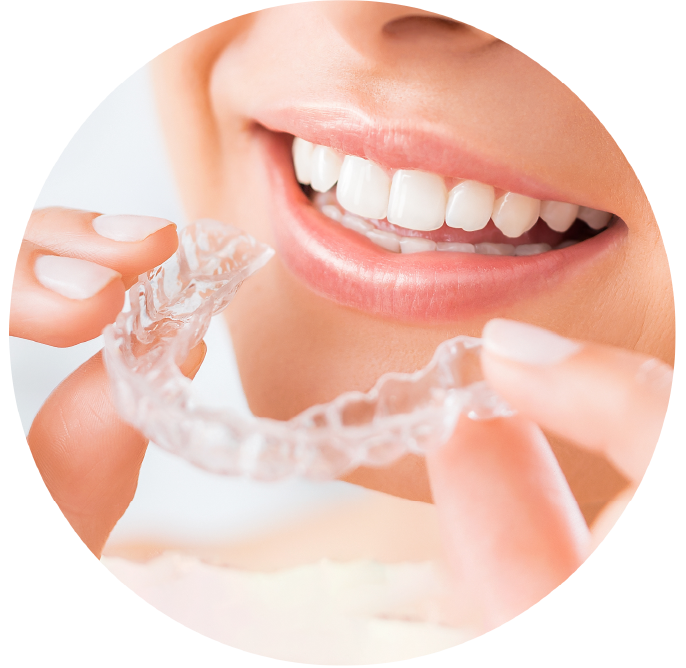
Invisalign in Edmonton

Tooth realignment procedures extend to a wide variety of treatment options for patients of all types. Depending on your specific needs, you may qualify for Invisalign, clear aligners that can take the place of braces or other corrective tools. Straightening crooked teeth not only improves your smile, but it can lead to overall better dental health, making brushing and flossing easier, reducing the risk of impacted teeth or gum disease.
Teeth straightening can be done not just by brackets and wires, but also by a series of clear, removable “trays” as well. The clear “trays” are called aligners. You wear each set of aligners for 2 weeks before changing to the next set. You need to wear the trays for 22 hours every day. Over time, this process gradually realigns teeth by putting gentle pressure on them, without the immediate and extreme adjustment that metal braces or a retainer would provide. Depending on the case, your treatment time varies from around 6 months to 2 years or more.

Clear Aligners for Personalized Dentistry
Many patients find clear aligners to be a preferable option, and Invisalign is a leading brand that customers love. Clear aligners are made out of tough clear resin plastic, custom-fitted to your teeth and yours alone. More than that, they conform so closely to your teeth that you can barely even see them, unlike braces or a retainer.
Because these invisible dental aligners are removable, you can eat and drink normally and you can brush your teeth, floss, and maintain dental hygiene, making Invisalign a convenient, easy choice for your tooth realignment needs without getting in the way of your daily routine.

Invisalign vs. Braces
Comparing Invisalign treatment to having braces can help you decide which type of aligners are best for you.
Ultimately, while a dentist may have recommendations, the decision is up to the patient.
To better help you decide which aligners are better for you to be wearing, consider the comparisons below:

Comfort
Braces aren’t the most comfortable experience and often include cuts into your lips or cheeks, hard-to-reach sores, and a host of other annoyances during treatment.
Invisalign has smooth edges and is a custom fit, removing cuts and the development of sores during treatment. Also, since Invisalign is a set of removable trays, it’s easier to reach any areas that need special attention.

Cleaning
Traditional braces can be brushed around but leave a great deal of space covered and that can make it more difficult to clean around the wires. If food gets behind any of the metal, you would need a small brush or try to pick the food out with another dental tool. Besides food, plaque easily gets stuck around and inside the brackets, which if left there can cause gum disease or tooth decay.
With Invisalign, you’re able to remove the trays and continue with your normal dental routine. Of course, you would also need to clean the inside of your Invisalign as well so that bacteria or food doesn’t build up inside of it.

Effectiveness
Both braces and Invisalign are highly effective for a range of dental treatments, from overbite to misaligned or crooked teeth. The effectiveness of both isn’t in despite, except for the opportunity a patient has to cause it. Since Invisalign trays can be removed and they’re supposed to be worn 22 hours a day, if a patient keeps them out beyond that then they could be less effective in treating your teeth. With braces, you don’t have that option, and while Invisalign treatments are often shorter than braces, not having the option to remove braces means they can be as effective as intended.
Invisalign Benefits
Earlier on this page, some of the benefits of Invisalign were outlined, but there are several others that should be highlighted in order for you to make a fully-informed decision.

Shorter Treatment Time
This was brought up in the previous section, but it’s worth noting again. Traditional braces can take between 16 to 18 months, sometimes longer than 2-years depending on the goal of the dental treatment and the patient’s circumstances teeth wise. Part of the reason braces take longer is due to not having a precise movement planned out.
Invisalign treatment is designed with a precise movement planned out and usually takes around a year to complete, assuming the patient is wearing them as instructed.

Fewer Dental Trips
With braces, it’s important to see your orthodontist frequently as braces will need to be adjusted and progress monitored. These dental office visits can include replacing a bracket, changing the wire size, tightening, or wiring with extra wires. These appointments are known to take several hours.
With Invisalign, you won’t need to have the kind of upkeep braces demand and the visits you do make to your dental office won’t be nearly as long. These visits are primarily to have a set of aligners switches and to ensure everything is moving as it should.

Easier Teeth Scanning
Before getting braces, you’ll have an extensive evaluation done of your teeth and mouth. This usually involves having plastic pieces in your mouth to spread your cheeks far for x-rays, scanning, and pictures to be taken. The plastic pieces are also used when a dentist is wiring the brackets on your teeth together.
For Invisalign, many dental offices use 3D scanning rather than traditional impressions. Skipping over the invasive evaluation that traditional braces require.
If you think Invisalign is the right treatment for you, Ellerslie 66 is a licensed Invisalign vendor that can assist you in finding the right tooth realignment procedure in Edmonton.
